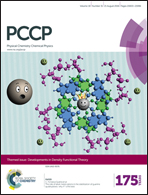Organics on oxidic metal surfaces: a first-principles DFT study of PMDA and ODA fragments on the pristine and mildly oxidized surfaces of Cu(111)†
Abstract
Metal–organic hybrid materials are ubiquitous and a fundamental understanding of the hybrid-interface is key for the development of these hybrid material systems. In this work, using first-principles density-functional theory (including van der Waals (vdW) corrections), we study the fundamental physico-chemical properties of the molecular fragments of pyromellitic dianhydride oxydianiline (PMDA–ODA) on pristine Cu(111), as well as oxidic p4:O/Cu(111) in order to investigate the effect of mild oxidation of the metal substrate on PMDA–ODA adsorption. Firstly, we report the most favorable adsorption geometries amongst the various surface models and correlate the adsorption behavior with the electronic structure of the molecular fragments and the substrate layer. PMDA adsorbs weakly on both the clean and mildly oxidized copper surface via vdW forces while ODA adsorbs much stronger with a significant charge transfer between the substrates. Here, the oxidic layer is found to reduce the adsorption strength of both fragments and in particular, the ODA molecule interacts with the substrate via additional hydrogen bonding. Finally, our simulated scanning tunneling microscopy (STM) images suggest possible orientations of PMDA and ODA on clean and oxidic Cu surfaces to guide future experiments.


 Please wait while we load your content...
Please wait while we load your content...